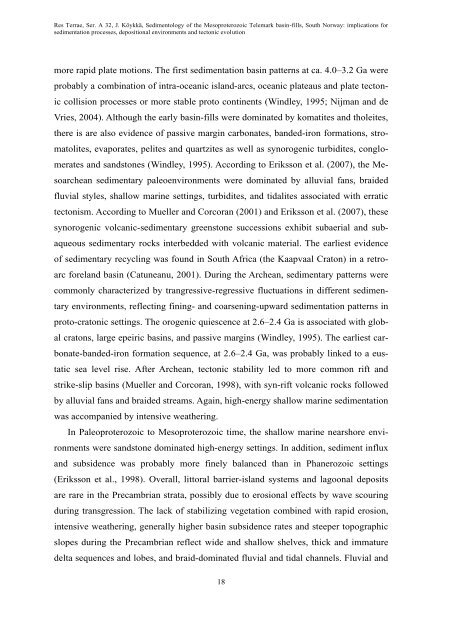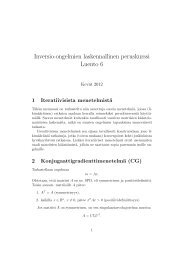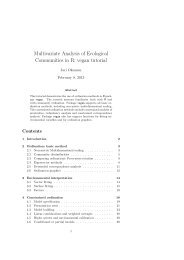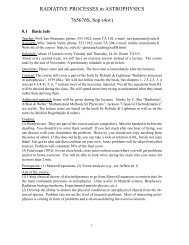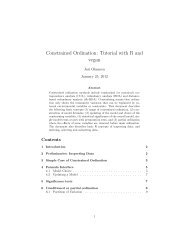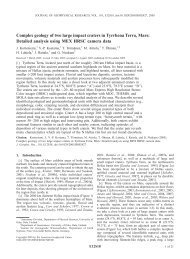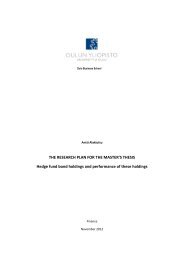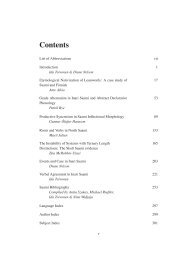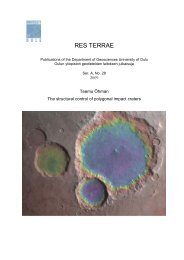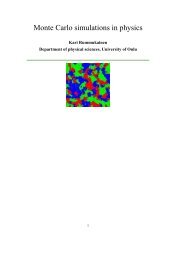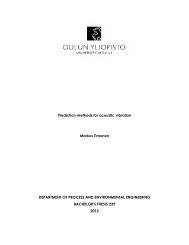Juha Köykkä - Oulu
Juha Köykkä - Oulu
Juha Köykkä - Oulu
- TAGS
- juha
- oulu
- cc.oulu.fi
Create successful ePaper yourself
Turn your PDF publications into a flip-book with our unique Google optimized e-Paper software.
Res Terrae, Ser. A 32, J. <strong>Köykkä</strong>, Sedimentology of the Mesoproterozoic Telemark basin-fills, South Norway: implications for<br />
sedimentation processes, depositional environments and tectonic evolution<br />
more rapid plate motions. The first sedimentation basin patterns at ca. 4.0–3.2 Ga were<br />
probably a combination of intra-oceanic island-arcs, oceanic plateaus and plate tecton-<br />
ic collision processes or more stable proto continents (Windley, 1995; Nijman and de<br />
Vries, 2004). Although the early basin-fills were dominated by komatites and tholeites,<br />
there is are also evidence of passive margin carbonates, banded-iron formations, stro-<br />
matolites, evaporates, pelites and quartzites as well as synorogenic turbidites, conglo-<br />
merates and sandstones (Windley, 1995). According to Eriksson et al. (2007), the Me-<br />
soarchean sedimentary paleoenvironments were dominated by alluvial fans, braided<br />
fluvial styles, shallow marine settings, turbidites, and tidalites associated with erratic<br />
tectonism. According to Mueller and Corcoran (2001) and Eriksson et al. (2007), these<br />
synorogenic volcanic-sedimentary greenstone successions exhibit subaerial and sub-<br />
aqueous sedimentary rocks interbedded with volcanic material. The earliest evidence<br />
of sedimentary recycling was found in South Africa (the Kaapvaal Craton) in a retro-<br />
arc foreland basin (Catuneanu, 2001). During the Archean, sedimentary patterns were<br />
commonly characterized by trangressive-regressive fluctuations in different sedimen-<br />
tary environments, reflecting fining- and coarsening-upward sedimentation patterns in<br />
proto-cratonic settings. The orogenic quiescence at 2.6–2.4 Ga is associated with glob-<br />
al cratons, large epeiric basins, and passive margins (Windley, 1995). The earliest car-<br />
bonate-banded-iron formation sequence, at 2.6–2.4 Ga, was probably linked to a eus-<br />
tatic sea level rise. After Archean, tectonic stability led to more common rift and<br />
strike-slip basins (Mueller and Corcoran, 1998), with syn-rift volcanic rocks followed<br />
by alluvial fans and braided streams. Again, high-energy shallow marine sedimentation<br />
was accompanied by intensive weathering.<br />
In Paleoproterozoic to Mesoproterozoic time, the shallow marine nearshore envi-<br />
ronments were sandstone dominated high-energy settings. In addition, sediment influx<br />
and subsidence was probably more finely balanced than in Phanerozoic settings<br />
(Eriksson et al., 1998). Overall, littoral barrier-island systems and lagoonal deposits<br />
are rare in the Precambrian strata, possibly due to erosional effects by wave scouring<br />
during transgression. The lack of stabilizing vegetation combined with rapid erosion,<br />
intensive weathering, generally higher basin subsidence rates and steeper topographic<br />
slopes during the Precambrian reflect wide and shallow shelves, thick and immature<br />
delta sequences and lobes, and braid-dominated fluvial and tidal channels. Fluvial and<br />
18


